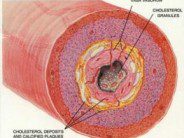 Progeria, also known as Hutchinson Gilford Progeria Syndrome, is a very rare genetic disease and occurs at an estimated incidence of 1 in 8 million live births. The term progeria is derived from the Greek words “pro” which means before and “geras” which means old age. The disease is characterized by accelerated aging that results in hair loss, bone deficits, growth failure, and hardening of the skin. The average lifespan of an individual with progeria is 13 years. These patients usually succumb to diseases of the cardiovascular system, such as heart attack and stroke. The disease is caused by a de novo point mutation in the LMNA gene which encodes a nuclear structural protein known as Lamin A. The normal Lamin A protein is part of the scaffolding machinery of the inner nucleus of the cell and serves to give strength and stability to this structure. The mutant LMNA gene produces an abnormal version of this protein known as progerin. Progerin causes nuclear blebs and bulges and accumulated at an accelerated rate within the cells of individuals with progeria. Progerin has also been found to accumulate in normal individuals at an estimated rate of 3% per year with higher levels later in life. The abnormal accumulation of progerin has been implicated as a cause of the characteristic accelerated aging that is seen in progeria. Researchers from the National Institutes of Health and Harvard Medical School, lead by Dr. Francis Collins, have shown that rapamycin can slow the cellular aging process seen in patients with progeria. The results of their study were published online in the journal Science Translational Medicine. Rapamycin (also known as Sirolimus) is a macrolide antibiotic that has been used as an immunosuppressant medication in organ transplant patients, and has been shown to extend longevity in yeast, invertebrates, and mammals. The researchers used cultured fibroblast cells from patient with progeria and treated them with rapamycin. The treated fibroblasts showed less nuclear blebbing, had delayed cellular senescence, and exhibited enhanced degradation of abnormally accumulated progerin. In addition, rapamycin decreased the accumulation of progerin aggregates in the fibroblast cells and induced increased clearance as a result of an autophagic mechanism. The researchers wrote, “We have shown that rapamycin abolishes characteristic nuclear defects, markedly prolongs cellular life span, and enhances the turnover of progerin in cultured [Hutchinson Gilford Progeria Syndrome] fibroblasts”. These results suggest that rapamycin could serve as a potential treatment for children with progeria. Researchers are now in the process of developing a clinical trial of everolimus, a rapamycin analog, for the treatment of progeria. In addition, these results have shed light onto the normal process of aging and could potentially lead to the development of medications to slow this process.
Progeria, also known as Hutchinson Gilford Progeria Syndrome, is a very rare genetic disease and occurs at an estimated incidence of 1 in 8 million live births. The term progeria is derived from the Greek words “pro” which means before and “geras” which means old age. The disease is characterized by accelerated aging that results in hair loss, bone deficits, growth failure, and hardening of the skin. The average lifespan of an individual with progeria is 13 years. These patients usually succumb to diseases of the cardiovascular system, such as heart attack and stroke. The disease is caused by a de novo point mutation in the LMNA gene which encodes a nuclear structural protein known as Lamin A. The normal Lamin A protein is part of the scaffolding machinery of the inner nucleus of the cell and serves to give strength and stability to this structure. The mutant LMNA gene produces an abnormal version of this protein known as progerin. Progerin causes nuclear blebs and bulges and accumulated at an accelerated rate within the cells of individuals with progeria. Progerin has also been found to accumulate in normal individuals at an estimated rate of 3% per year with higher levels later in life. The abnormal accumulation of progerin has been implicated as a cause of the characteristic accelerated aging that is seen in progeria. Researchers from the National Institutes of Health and Harvard Medical School, lead by Dr. Francis Collins, have shown that rapamycin can slow the cellular aging process seen in patients with progeria. The results of their study were published online in the journal Science Translational Medicine. Rapamycin (also known as Sirolimus) is a macrolide antibiotic that has been used as an immunosuppressant medication in organ transplant patients, and has been shown to extend longevity in yeast, invertebrates, and mammals. The researchers used cultured fibroblast cells from patient with progeria and treated them with rapamycin. The treated fibroblasts showed less nuclear blebbing, had delayed cellular senescence, and exhibited enhanced degradation of abnormally accumulated progerin. In addition, rapamycin decreased the accumulation of progerin aggregates in the fibroblast cells and induced increased clearance as a result of an autophagic mechanism. The researchers wrote, “We have shown that rapamycin abolishes characteristic nuclear defects, markedly prolongs cellular life span, and enhances the turnover of progerin in cultured [Hutchinson Gilford Progeria Syndrome] fibroblasts”. These results suggest that rapamycin could serve as a potential treatment for children with progeria. Researchers are now in the process of developing a clinical trial of everolimus, a rapamycin analog, for the treatment of progeria. In addition, these results have shed light onto the normal process of aging and could potentially lead to the development of medications to slow this process.
See the YouTube video on Progeria below:
Reference:
Kan Cao et al. “Rapamycin Reverses Cellular Phenotypes and Enhances Mutant Protein Clearance in Hutchinson-Gilford Progeria Syndrome Cells” Sci. Transl. Med. 3, 89ra58 (2011).










 DrSamGirgis.com is a blog about medicine, nutrition, health, wellness, and breaking medical news. At DrSamGirgis.com, the goal is to provide a forum for discussion on health and wellness topics and to provide the latest medical research findings and breaking medical news commentary.
DrSamGirgis.com is a blog about medicine, nutrition, health, wellness, and breaking medical news. At DrSamGirgis.com, the goal is to provide a forum for discussion on health and wellness topics and to provide the latest medical research findings and breaking medical news commentary.
{ 0 comments… add one now }